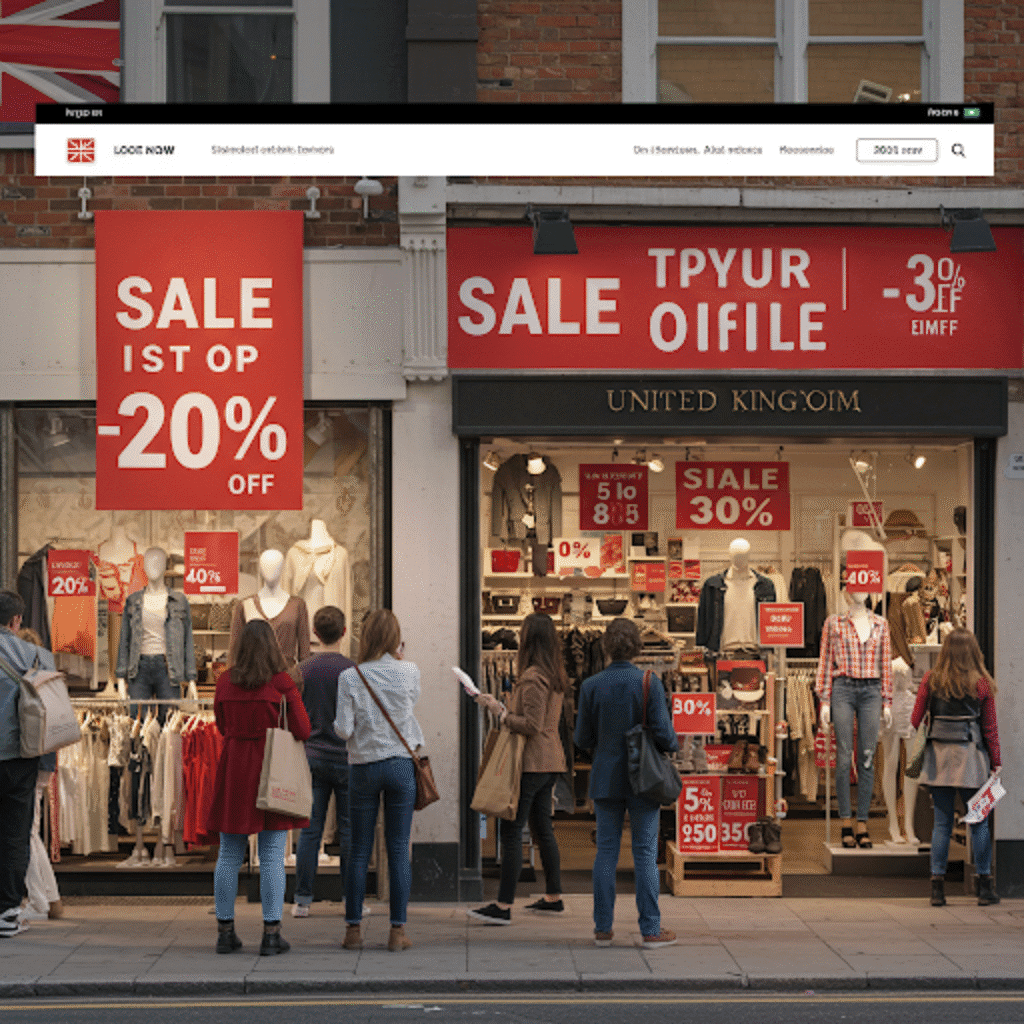
Unlock the Secrets of Savvy Shopping: Your Ultimate Guide to UK Sales
Ah, the thrill of the sale! That bright red sign, the promise of a percentage off, the feeling of snagging a bargain – it’s a retail rush many of us in the UK know and love. From the legendary Boxing Day scrambles to the online frenzy of Black Friday, sales periods are practically woven into the fabric of British shopping culture. But are you truly making the most of these opportunities? Or do you sometimes end up with buyer’s remorse, clutching a bag full of things you didn’t really need, lured in by the siren song of a discount?
Navigating the world of sales requires more than just enthusiasm; it demands strategy, patience, and a little bit of insider knowledge. This guide is designed to transform you from a casual sale browser into a savvy, deal-hunting expert. We’ll delve into the rhythms of the UK sales calendar, explore different types of discounts, share practical tips for maximising savings, and help you avoid common pitfalls. Get ready to shop smarter, save more, and truly master the art of the bargain.
Understanding the UK Sales Calendar: Timing is Everything
Sales aren’t just random occurrences; they follow a relatively predictable pattern throughout the year in the UK. Knowing when to expect major discounts can help you plan your purchases strategically.
The Big Players: Major Sale Events

- January Sales: Kicking off right after Christmas, often starting online on Christmas Day itself and hitting high streets on Boxing Day (or the day after, depending on the retailer), the January Sales are a cornerstone of British retail. Retailers are keen to clear out leftover festive stock and winter collections to make way for spring lines. Expect deep discounts on clothing (especially winter wear), electronics, home goods, and Christmas decorations for next year.
- Spring/Mid-Season Sales: Around March/April, as the weather starts to turn, retailers often hold mid-season sales to shift transitional stock. These might not be as extensive as the January or Black Friday events, but they’re a good time to pick up lighter jackets, knitwear, and potentially early discounts on garden furniture or spring cleaning essentials.
- Summer Sales: Typically starting in late June or early July, these sales aim to clear out summer stock – swimwear, shorts, t-shirts, sandals, garden items, and BBQ equipment – before the autumn collections arrive. Discounts often deepen as the sale progresses through August.
- Black Friday & Cyber Monday: Originally an American import post-Thanksgiving, Black Friday (the last Friday in November) has exploded in the UK over the past decade. It’s now arguably the biggest pre-Christmas sales event, heavily focused on electronics, gadgets, appliances, toys, and fashion. Cyber Monday, the following Monday, keeps the online deals rolling. Be prepared for intense competition and occasional website crashes!
- Boxing Day Sales: A true British tradition, the Boxing Day (26th December) sales historically saw queues forming in the early hours. While online shopping has lessened the physical crush, it remains a significant event, overlapping with the start of the January Sales. It’s a prime time for fashion, home furnishings, and anything retailers want gone before the new year.
- Bank Holiday Sales: Keep an eye out for smaller sales events centred around UK Bank Holidays (like Easter, May Day, August Bank Holiday). These often offer short-term discounts across various categories, perfect for a quick bargain hunt.
Beyond the Big Dates: Other Discount Opportunities
- Flash Sales: These are short-lived, often online-only, sales offering significant discounts on specific items or categories for a very limited time (sometimes just hours). Signing up for newsletters or following brands on social media is key to catching these.
- Clearance Sales: These happen whenever a retailer needs to clear out old stock – perhaps end-of-line items, products with slight imperfections (clearly marked), or stock from a closing branch. Discounts can be substantial, but sizes and selection may be limited.
- Outlet Stores: Many brands have dedicated outlet stores (often clustered in outlet villages) selling previous seasons’ stock, items made specifically for the outlet, or slightly imperfect goods at permanently reduced prices.
- Sample Sales: More common in the fashion industry, particularly in major cities like London, sample sales offer prototypes, runway samples, or excess stock at heavily discounted prices. They can be hectic but offer unique finds.
Decoding the Deals: Types of Sales and Offers
Not all discounts are created equal. Understanding the different types of offers helps you evaluate the real value.
- Percentage Off (% off): The most common type. A specific percentage is deducted from the original price (e.g., 20% off, 50% off). Always check the ‘original’ price to ensure it hasn’t been artificially inflated beforehand.
- Money Off (£ off): A fixed amount deducted from the price (e.g., £10 off when you spend £50). Often used to encourage a minimum spend.
- Buy One Get One Free (BOGOF): Exactly what it says. Great if you need two of the item, but less valuable if you only wanted one. Sometimes variations exist like ‘Buy One Get One Half Price’.
- Multi-buy Offers: Discounts for buying multiple items (e.g., 3 for 2, 2 for £20). Good for stocking up on essentials, but only if you genuinely need the quantity. Calculate the per-item cost to see the true saving.
- Tiered Discounts: Savings increase the more you spend (e.g., 10% off £50, 15% off £100, 20% off £150). Can encourage overspending if you’re not careful.
- Free Gift with Purchase: Often used in beauty or electronics. Consider if the free gift is something you actually want or need.
Mastering the Sale: Strategies for Maximum Savings
Going into a sale armed with a plan is the difference between bagging bargains and busting your budget.
1. Preparation is Paramount
- Make a Wish List: Throughout the year, note down items you actually need or genuinely want. When sales hit, consult your list first. This curbs impulse buys.
- Research Prices Beforehand: Use price comparison websites (like PriceRunner, CamelCamelCamel for Amazon, Google Shopping) to track the price history of items on your list. This helps you recognise a genuinely good deal versus a minor reduction or misleading discount.
- Set a Strict Budget: Decide exactly how much you can afford to spend *before* you start Browse. Stick to it rigorously.
- Know Your Sizes: Especially for online clothes shopping, knowing your measurements and sizes in different brands saves time and reduces the likelihood of returns. Check size guides carefully.
2. Timing and Tactics
- Shop Early for Choice, Late for Deeper Discounts: Often, the best selection is available at the start of a sale. However, as the sale progresses, retailers may apply further reductions (‘further markdowns’) to clear remaining stock, especially towards the end of January or August.
- Online vs. In-Store: Online shopping offers convenience, easy price comparison, and access to online-exclusive deals or codes. However, you can’t physically inspect items, and delivery costs can add up. In-store allows you to see and try items, and you get them immediately, but it can be crowded and stock may be limited. A hybrid approach often works best – research online, then potentially buy in-store or use click-and-collect.
- Use Browser Extensions: Tools like Honey, Pouch, or Rakuten automatically search for and apply voucher codes at checkout, potentially saving you money effortlessly.
3. Leverage Loyalty and Vouchers
- Sign Up for Newsletters: Many retailers offer a discount (e.g., 10-15% off) just for signing up to their email list. They also often provide subscribers with early access to sales or exclusive codes. Create a separate email address for promotional emails if you’re worried about clutter.
- Join Loyalty Programmes: Supermarkets (Tesco Clubcard, Nectar), chemists (Boots Advantage Card), and many fashion retailers offer loyalty schemes. Points can often be converted into vouchers or provide access to member-only discounts.
- Hunt for Voucher Codes: Check dedicated voucher code websites (like VoucherCodes, MyVoucherCodes) before making any online purchase. Sometimes stacking a voucher code on top of a sale price is possible for extra savings.
- Social Media Savvy: Follow your favourite brands on platforms like Instagram or Facebook, as they often announce flash sales or special promotions there first.
4. Know Your Rights
- Returning Sale Items: Your rights when buying sale items in the UK are protected under the Consumer Rights Act 2015. If an item is faulty, not as described, or unfit for purpose, you are entitled to a refund, repair, or replacement, regardless of whether it was on sale. However, retailers are *not* legally required to offer a refund on sale items if you simply change your mind, although many do as a gesture of goodwill. Always check the specific retailer’s return policy for sale goods *before* buying, especially online where distance selling regulations usually grant a 14-day cooling-off period to return items for any reason (though some exclusions apply).
Beyond the High Street: Year-Round Bargain Hunting
Savvy shopping isn’t just about the big seasonal events. Opportunities for savings exist all year round if you know where to look.
- Outlet Villages: Locations like Bicester Village, Cheshire Oaks, or Gunwharf Quays offer collections of brand outlet stores. They sell past-season stock or items made specifically for the outlet market at reduced prices. Quality can vary, but genuine bargains are possible.
- Charity Shops: A treasure trove for the patient hunter. Find high-quality clothing, books, homewares, and furniture at incredibly low prices while supporting good causes. The stock changes constantly, so regular visits pay off.
- Online Marketplaces: Sites like eBay, Vinted, Depop, and Facebook Marketplace are hubs for second-hand goods. You can find everything from nearly-new fashion to vintage furniture, often at a fraction of the original price.
- Supermarket Savings: Beyond weekly offers, look for ‘yellow sticker’ reductions on food nearing its sell-by date, usually later in the evening. Loyalty card prices (like Tesco’s Clubcard Prices or Sainsbury’s Nectar Prices) can offer significant savings on groceries.
- Price Matching: Some retailers (like John Lewis, Currys) offer price matching policies. If you find an identical item cheaper at a competitor (meeting their specific criteria), they may match the price. Check individual store policies for details.
- Refurbished Goods: Reputable retailers often sell refurbished electronics (laptops, phones, etc.) that have been returned, checked, repaired, and restored to full working order. They come with warranties and offer significant savings compared to buying new.
Avoiding the Sale Traps: Shop Smart, Not Hard
Sales environments are designed to encourage spending. Stay vigilant to avoid common pitfalls.
- The Impulse Buy Danger: Ask yourself: Would I buy this if it wasn’t on sale? Do I actually need it? Does it fit my lifestyle/wardrobe? If the answer is no, step away, even if the discount seems huge.
- Beware Misleading Discounts: Look out for prices that seem artificially inflated just so the percentage discount looks bigger. Use your prior price research to judge the true value. Phrases like “Was £100, Now £50” are only meaningful if it genuinely sold at £100 recently.
- Don’t Sacrifice Quality: Sometimes items are heavily discounted because they are lower quality or from a diffusion line made specifically for sales or outlets. Inspect items carefully for materials and construction, just as you would at full price. A bargain isn’t a bargain if it falls apart after two wears.
- Factor in Hidden Costs: Especially online, check delivery fees before getting excited about a price. Also, consider potential return costs if you need to post an item back.
- Pressure Selling Tactics: Limited-time offers, “low stock” warnings, and countdown timers are designed to create urgency. Take a breath and don’t be rushed into a decision you might regret.
The Evolving World of Sales
The retail landscape is constantly changing. We’re seeing more personalised offers based on shopping history, dynamic pricing online where costs fluctuate based on demand, and AI playing a bigger role in predicting trends and managing stock, which influences sale strategies. Furthermore, a growing awareness of sustainability is encouraging more people to consider second-hand options or to buy less but better quality, potentially shifting focus away from fast-fashion sale frenzies towards more considered purchases.
Your Sale Success Strategy
Mastering the UK sales scene is about blending preparedness with patience and a healthy dose of scepticism. It’s about celebrating the joy of finding something you love or need at a genuinely reduced price, not just accumulating ‘stuff’ because it was cheap.
By understanding the sales calendar, knowing the different types of offers, employing smart shopping strategies, and being aware of the psychological tricks at play, you can navigate any sale – online or on the high street – with confidence. Create your wish lists, set your budgets, do your research, and utilise the tools available. Happy (savvy) shopping!







